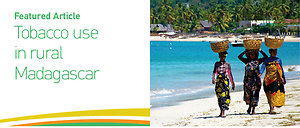Dear Editor,
Since the 2005 WHO Framework Convention on Tobacco Control set guidelines to reduce tobacco use worldwide, progress reducing tobacco use has varied widely by country. Low-and-middle-income countries (LMICs) in Africa and the Eastern Mediterranean have seen a rapid rise in tobacco use1. Notably, the 2008 Demographic Health Survey (DHS) demonstrated an exceptionally high tobacco use rate in Madagascar, 48.9% for men and 10.3% for women2. The high rate of tobacco use is especially concerning considering that premature death rates from stroke and ischemic heart diseases, conditions associated with tobacco use, have risen rapidly in Madagascar in recent decades3.
The 2008 DHS revealed that individuals of both sexes residing in rural areas were more likely to use smokeless tobacco products – namely chewing and snuff tobacco – than individuals residing in urban areas4. To better understand the factors contributing to this discrepancy in tobacco use patterns, we conducted a health survey in rural Northern Madagascar.
We collected data through a voluntary survey of visitors (N=338) to a non-profit health clinic between June and July 2019 in the village of Maventibao, five hours by dirt road from the nearest city, Antsiranana. This Mayo Clinic IRB and Antsiranana Ministry of Health approved survey asked for participants’ village, age, sex (female or male), current tobacco use (smoking, chewing, and snuff), number of cigarettes smoked per day (if a smoker), and occupational status (farmer, miner, other manual services, non-manual service, or unemployed). Occupational status categories aligned with prior research4,5. Table 1 summarizes demographics by sex, occupation, and tobacco use.
Table 1
Gender, occupation status, and tobacco use of participants (N=338)
| Occupation status | Tobacco use | ||
|---|---|---|---|
| Male participants (n=143) | Smoking tobacco (n=75) | Smokeless tobacco (n=16) | No tobacco (n=56) |
| Farming (43) | 12 | 5 | 14 |
| Mining (38) | 5 | 0 | 10 |
| Other manual service* (13) | 0 | 1 | 4 |
| Non-manual service** (20) | 3 | 2 | 3 |
| Unemployed (1) | 0 | 1 | 0 |
| NA (102) | 55 | 7 | 25 |
| Female participants (n=195) | Smoking tobacco (n=17) | Smokeless tobacco (n=25) | No tobacco (n=153) |
| Farming (69) | 7 | 9 | 53 |
| Mining (40) | 3 | 6 | 29 |
| Other manual service* (6) | 0 | 0 | 5 |
| Non-manual service** (28) | 0 | 0 | 20 |
| Unemployed (16) | 2 | 1 | 13 |
| NA (124) | 5 | 9 | 32 |
A greater proportion of men used tobacco than women (60.84% vs 22.05%, p<0.001). Furthermore, men were more likely to smoke tobacco than women (52.45% vs 8.72%, p<0.001). There was a significant difference in occupational status between gender, with a larger proportion of women in farming or unemployed, and more men working in other manual services (p<0.005).
The rate of male tobacco use was nearly double that reported by the 2008 DHS2. This rate may imply a regional anomaly in rural tobacco use or a significant shift in tobacco use patterns within the previous decade. Despite Madagascar having the highest federal tax rate on commercial tobacco products in Sub-Saharan Africa (80.4%), this increase persists6. Locally grown tobacco and hand-rolled cigarettes are widely sold and consumed in rural Madagascar, possibly to evade high taxation rates5. It would be valuable to investigate further how the utilization of untaxed locally grown tobacco products relates to changes in taxation policies.
Among females, the predominance of smokeless tobacco use (12.82%) over cigarette use (8.72%) was consistent with the 2008 DHS2. Social factors driving female use of smokeless tobacco in Madagascar may exist early in adolescence resulting from adult role models or peer pressure at school, as suggested by recent research7. Future studies may explore how gender differences in occupation affect exposure to social factors influencing tobacco use and product choice.


